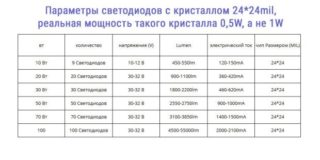Powerful LEDs are elements with high luminescence, brightness (more than 300 lm / W), power (10 - 100 W). Initially, they were used as indicator lamps, but today they are relevant for arranging lighting. LED lamps are designed for 50 thousand hours of operation from a 6-72 V power supply, which allows users to save on electricity bills.
Crystal sizes
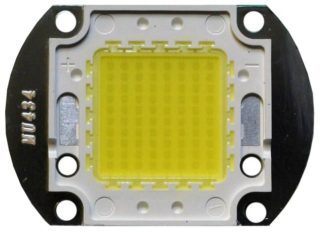
The super-bright element is built on crystals, the sizes of which are indicated as mil - a thousandth of an inch. If you translate the value into millimeters, you get 0.0254 mm. Standard die sizes are 30x30 and 45x45 mil.
Experts use digital vernier calipers with sharp points to determine crystal size. The tool allows you to identify the value with an accuracy of 0.01 mm. It is enough for the average person to know that size is correlated with power:
- 1 W - 45x45 mil or 30x30 mil;
- 0.75 W - 24x40 mil;
- 0.5 W - 24x24 mil.
Manufacturers recessed the crystal of the LED in the case, therefore, a micrometer is not used for measurement.
Varieties of powerful LEDs
The high power LED is a high power light emitting diode. The elements have a wavelength of 650 to 660 nm, the scatter is seen at an angle of 160 degrees. Semiconductor devices are classified into several groups.
Single-chip
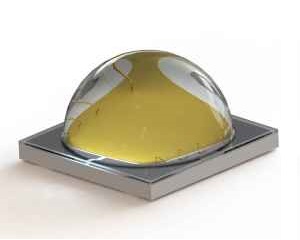
The lighting elements have small dimensions, but high density and decent glow intensity. Features of single-chip options include:
- the light beam is directed to the edges;
- illumination angle - from 100 to 145 degrees;
- color rendering - CRI 70–90;
- power - up to 3 W;
- luminous flux brightness - up to 334 lm.
To make one wide-angle luminaire, it takes less single-chip LEDs than standard bulbs.
Multichip
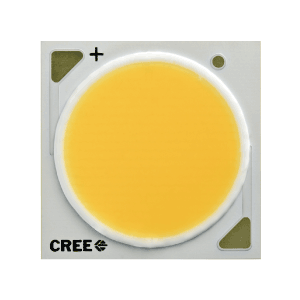
A feature of solid-state cells is the power, which depends on the magnitude of the voltage. The current strength is 3000 mA. Manufacturers produce lines of multichip LEDs powered from 6 to 72 V. Classification:
- high voltage elements;
- elements with power less than 4 W;
- elements with a power of more than 4 watts.
Multichip SMD sources have a white or colored glow.
Up to 4 W
Ultra-bright LEDs with power ratings up to 4W are available in MX and ML variants. They differ in the type of body, but are similar in the angle of the glow of 120 degrees. The devices give out a cold and warm glow, and their light output is related to the power. The increased supply voltage increases the life of the cells without affecting the light quality.
More than 4 W
- luminous flux from 250 to 2100 lm;
- energy efficiency - the largest lamp consumes 12 W;
- the presence of an open diode or matte bulb;
- self-cooling system.
The largest representative of the line is made in a 7x7 mm case.
5mm LEDs
The trick of the devices is a reflector with a phosphor that emits a bright light. A reflector without a lens is inserted into the lantern, and the light spot is focused on one area.
Semiconductor elements 5 mm in diameter have an operating voltage of 1.9-3.4 V.The current strength is 20 mA, and the luminous intensity is from 30 to 30 thousand mcd. The brightest 5mm LEDs are available in white (cool and warm), blue, red, orange, green or yellow.
High voltage supply
It is recommended to use high voltage versions with a diffuser.
Colored
Royal blue
Compared to standard designs, Royal Blue is 30% more efficient.
COB matrices
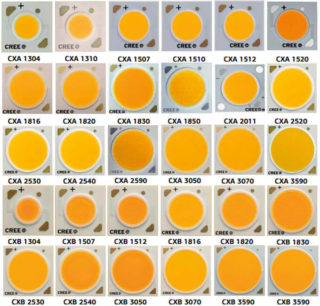
The technology of numerous crystals on a board, or Chip-on-Board, provides for the installation of elements without a case or support. All crystals are closely spaced, covered with a common phosphor layer. The density with the COB technology is 70 crystals / 1 cm 2, so the LEDs have a uniform glow. The standard luminous layer of the COB matrix is a square with sides of 1-3 cm or a circle of the same diameter.
Thanks to the Chip-on-Board, the manufacture of a light source with the dimensions of a luminous element equal to DNaT or MGL is being established. A bright flashlight with the same glow will have a power of 100-150 watts.
Most often, COB diodes are used for outdoor lighting or the production of photographic equipment (CRI greater than 95).
High-Brightness LEDs
Super powerful and bright High-Brightness LEDs are characterized by a current value of 20-70 A. Available in color and white. The number of shades of radiation depends on the number of anode-cathode pairs. The directionality of the light of LED-components ensures their use for outdoor advertising - billboards, signboards, light boxes.
PLCC
Modifications of LEDs on one or several crystals, suitable for outdoor installation. The dimensions of SMD devices allow you to choose them for accent lighting or creeping display.
P4
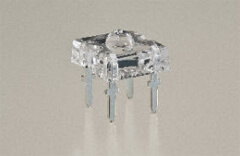
LEDs - "Piranhas" are made in a square case of epoxy compound. The lens surface is concave, convex, or oval, which contributes to a uniform flow direction. The scattering angle can be greater than 120 degrees. There are 4 metal pins designed to fix the lamp. The dimensions of the elements are 3-7.7 mm. They carry up to 50 mA of current at 4.5 V.
Improved diffusion properties, a durable backing and several color options for a luminescence allow the devices to be used in outdoor advertising and auto tuning.
Round
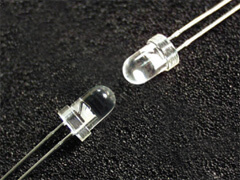
Superbright LED is better than COB in terms of light performance, since it is manufactured using Chip On Glass technology (chip on glass). Round low-current elements are located in an optical case with a diameter of 5 mm made of epoxy. During operation, they consume 20 mA of current. The visible viewing angle is 360 degrees, which is better than a flat matrix. There are options with and without output constraints.
1 filament LED lamp is comparable in light intensity to a 60W incandescent lamp.
Oval
Unique in design, LEDs can emit light streams in two directions. The models are designed for a current strength of 20 mA, they are not damaged by ultraviolet radiation, wet gray hair, temperature surges. The large dispersion angle justifies the use of oval elements to create huge LED screens.The light source housing is only 4 mm.
The scattering of light fluxes by oval LEDs occurs along the X and Y axes.
Lighting indicators
- power - 10 W;
- operating voltage - 12 V;
- energy efficiency indicator - up to 170 lm / W;
- luminous flux - 850 lm (current 3 A);
- base parameters - 5x5 mm;
- light temperature - from 4000 to 5000 K.
With a current strength of more than 3 A, the light element produces about 910 lm.
Base material
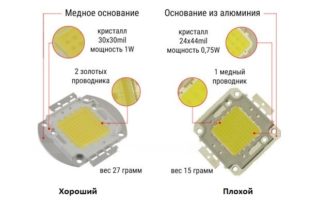
The base is designed to hold crystals. It is created from the following materials:
- Aluminum. Low-cost LEDs are characterized by insufficient thermal conductivity, they glow during operation. The aluminum base can be distinguished by its light weight;
- Copper. It removes heat well from the chip, but has more weight. The diodes heat up during operation.
LEDs with a power of 10 - 100 W with a copper base should weigh 2-3 times more than standard 5 W.
LED element conductors
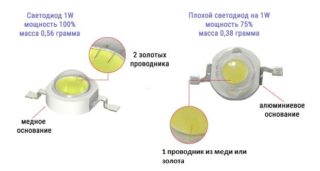
The thinnest conductor ensures the quality of the crystal connection to the power supplies. A good product is made of gold, there are 2 elements on one contact. The characteristic of the conductors is most pronounced in the automotive backlight. The gold element can withstand vibrations up to 30 V, while the copper one burns out.
Lenses for optics
Modern brands produce specialized optical systems with different radiation patterns (elliptical, for 3 LEDs). The basis for obtaining the directivity of parallel light beams is a collimator. It is made in the form of a hole in an absorbent coating with a different cross-sectional shape. The radiation source is located at one end of the collimator.
Scope of application
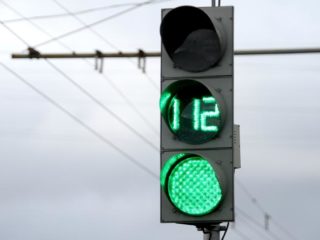
Energy-saving LED luminaires with a low ripple coefficient are used in places where bright illumination is required:
- decoration of premises - suitable for 220 V mains voltage;
- production of vehicles - on the dashboard, displays, signaling, turn signals;
- street lighting;
- outdoor advertising - city lights, creeping lines, information panels, billboards;
- entertainment establishments - accent lighting of zones;
- greenhouses and greenhouses - streams of a certain color stimulate plant growth;
- aquarium lighting.
The popularity of LEDs is associated with the ability to obtain ultra-brightness without special costs for electricity.
The assortment of LED products allows you to realize ideas for interior decor, to attract the audience by decorating the sign of the institution. Operation of LEDs allows saving on replacement of incandescent lamps - their service life is equal to 30-50 thousand hours.





